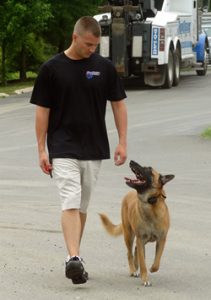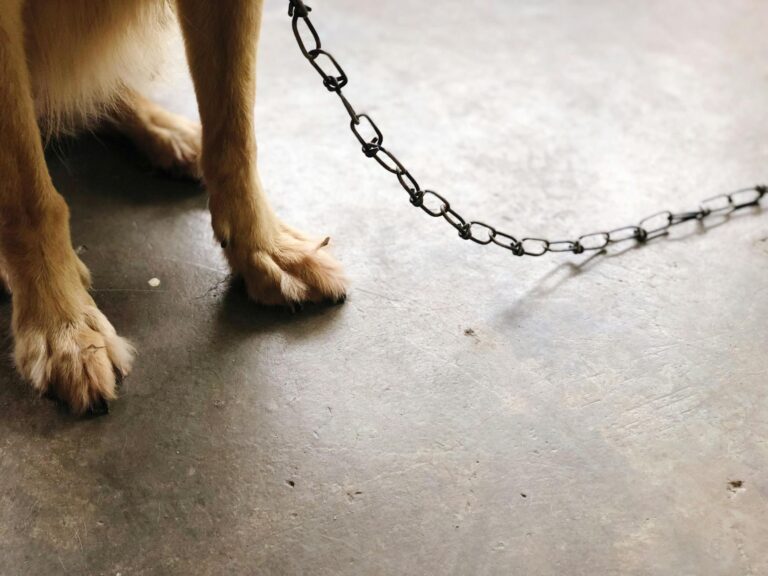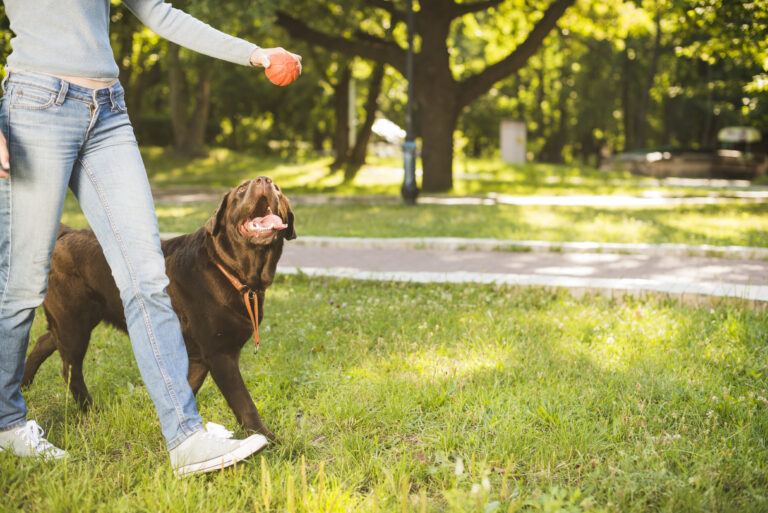My Dog Drags Me On The Leash! How To Get My Dog To Heel?
Training a dog to heel is one of our most requested and needed commands at our dog training facility in Northern Virginia. We currently have over 430+ Before/After videos on our Youtube Channel, most of these videos show dogs we have trained off-leash heeling with distractions. The picture above is me working a Belgian Malinois on a focused heel, this is an advanced form of off leash heeling, where the dog stares at you the entire time they are heeling.
There are a few KEY of elements in order to get a nice, solid, on or off leash heel:
Correction: In order to get a solid military/police precision heel, I am a believer that with the vast majority of dogs, there has to be a correction for the unwanted pulling; however, the correction is delivered is based upon your dog training program that you are enrolled in. You can read about the different dog training methods here in my blog, “The Pro’s and Con’s of Different Dog Training Methods.” As I say on a daily basis, “I have never seen a dog (or a child) that has impressed me in obedience that did it solely through a reward-based program.” Military dogs, police dogs, and ring dogs are the most confident and obedient dogs in the world, none of them solely use a reward-based system.
Pick A Side: Pick a side on the left or right and stick to it! Our dogs we train to heel on the left, NO EXCEPTIONS. Never on the right, never in front, never behind, always on the left! Consistency is the key! It’s much easier for them to learn to always heel on the left, no exceptions, than to learn to “generally” heel on the left, but sometimes on the other side, too!
Pace: I am a huge advocate of what I call “pace-variation.” If you watch our numerous videos, you will see me heeling a dog and walking at a fast pace, and then suddenly I will walk at a very slow pace and you will see the dog automatically adapt. Then, I will repeat this; walking normal, speeding up, slowing down, etc. This teaches the dog that irregardless of whom is walking them, they have to modify THEIR pace to that person, not the other way around. You can see a great example of this pace variation in this 140lb uncontrollable Great Dane that we trained.
http://www.youtube.com/watch?v=KyG7qHhOEdA
Direction: As I tell our clients on a daily basis, ensure YOU also control the direction of the walk; meaning, never change the direction you are walking in order to adapt to your dog. For example, if your dog pulls you to the left, most owners will go to the left to accommodate the dog, this is wrong. You keep walking in the same direction that you were going and make your dog adapt to your direction, not vice-verse. If your dog pulls one direction and you go that direction, you simply taught your dog that they are a steering wheel and whichever way they pull, you follow. You can see owners that have adapted their direction to accommodate their dogs in these before/after videos.


Avoidance Behaviors: An avoidance behavior is something that your dog will do in order to help control the walk or the breaks during the walk. Some of these avoidance behaviors are stopping and sitting as you are walking them, marking on everything, lying down, stopping and scratching, etc. These are all things that owners allow their dogs to do during a walk, which teaches the dog that they can control the starting and the stopping of the walk. Never let your dog control the walk with avoidance behaviors, if we are heeling a dog and they stop (by marking, sitting, scratching, etc), we simply correct them and keep walking, NOT changing our pace whatsoever.
Anyone who has worked with me onheel lessons at my dog training facility in Northern Virginia, has undoubtedly observed me doing this. I will be working the dog on a heel, the dog will stop, sit, and start scratching (for example), I correct and just keep walking at the same pace and in the same direction without skipping a beat. Again, “I” control the walk, not the dog.
Consistency in Leash Length: This is something that most people do not consider, even most “trainers.” If you are giving your dog a correction based off of when they create tension on the leash (which is the proper way to do it), THE LENGTH OF LEASH THEY HAVE SHOULD ALWAYS BE THE SAME! Amazing concept, right? You cannot correct your dog based off of them pulling on the leash, yet the amount of leash you give them changes every time you walk them, your significant other walks them, etc. In order to TRULY make it fair and easy for your dog to understand, they should always have the same amount of leash between your hand and their collar. We tie a knot in the leash to ensure every time we heel the dog, we are giving them the same amount of leash as last time.
Opposition Reflex: Whatever the dog does, we do the opposite to counter it. If they slow down, we speed up and correct. If they speed up, we slow down and correct.
Lastly….
Patience: Every single day we hear people say, “My dog doesn’t heel with with distractions.” We then see their dog, and their dog doesn’t heel with WITHOUT distractions. Or, “My dog cannot off leash heel,” and then we see their dog and their dog isn’t good at ON leash heeling. So, you dog should literally be flawless at on-leash heeling before you even consider distraction work or off leash work.
If you are having a lot of trouble with your dog on a walk, find a qualified trainer in your area that can assist you with getting your dog’s heeling perfect!
Here is a recent before and after video of a German Shepherd that we just recently did a heel lesson with:

www.offleashk9training.com
www.facebook.com/offleashk9
www.youtube.com/offleashk9training





